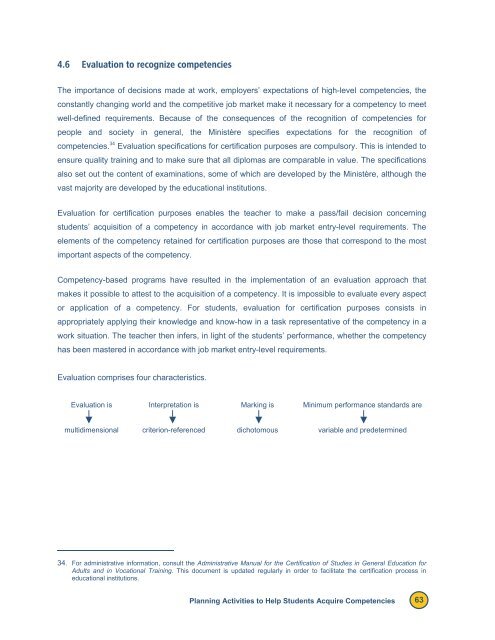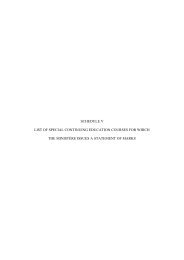Reference Framework for Planning Learning and Evaluation Activities
Reference Framework for Planning Learning and Evaluation Activities
Reference Framework for Planning Learning and Evaluation Activities
You also want an ePaper? Increase the reach of your titles
YUMPU automatically turns print PDFs into web optimized ePapers that Google loves.
4.6 <strong>Evaluation</strong> to recognize competencies<br />
The importance of decisions made at work, employers’ expectations of high-level competencies, the<br />
constantly changing world <strong>and</strong> the competitive job market make it necessary <strong>for</strong> a competency to meet<br />
well-defined requirements. Because of the consequences of the recognition of competencies <strong>for</strong><br />
people <strong>and</strong> society in general, the Ministère specifies expectations <strong>for</strong> the recognition of<br />
competencies. 34 <strong>Evaluation</strong> specifications <strong>for</strong> certification purposes are compulsory. This is intended to<br />
ensure quality training <strong>and</strong> to make sure that all diplomas are comparable in value. The specifications<br />
also set out the content of examinations, some of which are developed by the Ministère, although the<br />
vast majority are developed by the educational institutions.<br />
<strong>Evaluation</strong> <strong>for</strong> certification purposes enables the teacher to make a pass/fail decision concerning<br />
students’ acquisition of a competency in accordance with job market entry-level requirements. The<br />
elements of the competency retained <strong>for</strong> certification purposes are those that correspond to the most<br />
important aspects of the competency.<br />
Competency-based programs have resulted in the implementation of an evaluation approach that<br />
makes it possible to attest to the acquisition of a competency. It is impossible to evaluate every aspect<br />
or application of a competency. For students, evaluation <strong>for</strong> certification purposes consists in<br />
appropriately applying their knowledge <strong>and</strong> know-how in a task representative of the competency in a<br />
work situation. The teacher then infers, in light of the students’ per<strong>for</strong>mance, whether the competency<br />
has been mastered in accordance with job market entry-level requirements.<br />
<strong>Evaluation</strong> comprises four characteristics.<br />
<strong>Evaluation</strong> is Interpretation is Marking is Minimum per<strong>for</strong>mance st<strong>and</strong>ards are<br />
multidimensional criterion-referenced dichotomous variable <strong>and</strong> predetermined<br />
34. For administrative in<strong>for</strong>mation, consult the Administrative Manual <strong>for</strong> the Certification of Studies in General Education <strong>for</strong><br />
Adults <strong>and</strong> in Vocational Training. This document is updated regularly in order to facilitate the certification process in<br />
educational institutions.<br />
<strong>Planning</strong> <strong>Activities</strong> to Help Students Acquire Competencies 63




